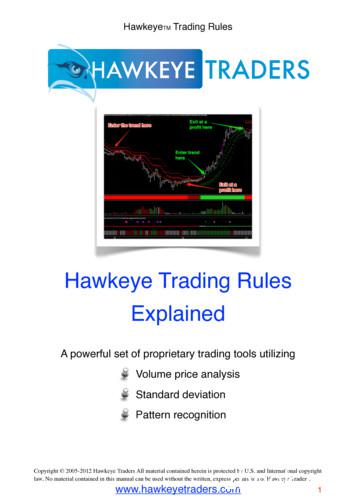Trading And Investment Strategies: An Introduction To .
Trading and Investment Strategies1Trading and Investment Strategies:An Introduction to Analyzing and Developing EfficientPortfolio Management and Currency Trading StrategiesBy:Abrin BerkemeyerJacob BillingtonKieran CochraneMatthew PukstaAdvisors: Professor Hossein Hakim and Professor Michael J. RadzickiThis report is submitted to the faculty of Worcester Polytechnic Institute as fulfillment of theInteractive Qualifying Project; a partial fulfillment of the Bachelor of Science Degree.This report represents work of WPI undergraduate students submitted to the faculty as evidence ofa degree requirement. WPI routinely publishes these reports on its web site without editorial or peerreview. For more information about the projects program at WPI, seehttp://www.wpi.edu/Academics/Projects.
Trading and Investment Strategies21 ABSTRACTThe purpose of this report is to provide an introduction to investing through the analysis ofour Interactive Qualifying Project. The report spans the concepts of basic economics, investablemarkets, creating a methodology for investing, and a breakdown of individual strategies. Theseconcepts, all taken into consideration, culminate in the presentation of our four individual strategiesin this report; all of which were implemented over the course of the project. Our individualstrategies demonstrate the steps of trading strategy development, implementation, and resultsanalysis. Three of the four strategies present different currency trading techniques: a trend followingstrategy, a stochastic, average directional index, and relative strength index strategy, and a strategybased off of major economic news. The fourth strategy is an equity based strategy focused primarilyon trading stocks that are affected by election years.
Trading and Investment Strategies2 ACKNOWLEDGEMENTSWe would like to thank Professor Radzicki and Professor Hakim for being our projectadvisors. Without their help, guidance, and overall knowledge of the investing world, our IQPexperience would have been undoubtedly limited. Professor Radzicki’s guidance with codingautomated trading served great functionality in the project. Professor Hakim’s availability to answerquestions and to discuss his personal trades gave substantial insight into trading currencies in thisproject and the real world.Furthermore, we would like to thank the WPI Investment Association for allowing us toshare what we learned during this IQP with our peers and WPI for this opportunity.3
Trading and Investment Strategies43 CONTENTS12456789Abstract . 2Acknowledgements . 3Introduction . 6Background. 75.1Financial Terminology . 75.2Basic Economics . 75.2.1Supply and Demand . 75.2.2Business Cycles. 85.3Investable Markets . 95.3.1Equity Market . 95.3.2Currency Market .155.3.3Options Market .185.3.4Futures Market .215.4Entering and Exiting a Market .235.4.1Long Positions.235.4.2Short Positions .235.4.3Relationship between Long and Short Positions .245.4.4Positions in the Options Market.255.4.5Positions in the Futures Market .255.4.6Entry Order Types.255.4.7Exit Order Types .265.5Market Movement .26Methodology .286.1Strategy Development .286.2Analyzing a Trade.306.3Indicators and Strategies .316.3.1Moving Averages .316.3.2Stochastic Oscillator .336.3.3Relative Strength Index .346.3.4Average Directional Index .356.3.5Long Term Equity Trading .35Abrin Berkemeyer’s Strategy .367.1Personal History and Background Information .367.2Strategy Development .367.3Final Strategy.407.4Implementation, Results, and Analysis .41Jacob Billington’s Strategy .448.1Foreign Exchange Strategies.448.2Equity Market Trading .478.3Results .48Kieran Cochrane’s Strategy .52
Trading and Investment Strategies59.1Strategy development.529.2Results .5810 Matthew Puksta’s Strategy .6210.1 Equity Trading and Portfolio management .6210.2 Results .6811 Conclusions .6912 Citations .7013 Appendix A: Trade History and Strategy Code .7213.1 Abrin Berkemeyer’s Trades And Code .7213.2 Jacob Billington’s Strategy Code .7413.3 Kieran Cochrane’s Trades And Code .7613.4 Matthew Puksta’s Trades . 10314 Appendix B: Journals . 10414.1 Abrin Berkemeyer’s Journal Entries . 10414.2 Jacob Billington’s Journal Entries . 11614.3 Kieran Cochrane’s Journal Entries . 11714.4 Matthew Puksta’s Journal Entries . 12215 Terminology Glossary . 125
Trading and Investment Strategies64 INTRODUCTIONThe purpose of this Interactive Qualifying Project is to learn how to manage one’s wealththrough creating and implementing different investment strategies. Managing one’s wealth is one ofthe most under-emphasized needs for most college aged students today. Protecting and growingone’s savings is something that is rarely taught. As a group of Worcester Polytechnic Institutejuniors preparing to enter the workforce in less than two years, we sought to learn, develop, and teststrategies that we could use in our future to invest and manage our wealth.Entering the working world, it is important to start saving for retirement as soon as possible.One of the most proactive ways to prepare for the future is learn how to manage one’s own wealth.More often than not, personal retirement funds and investment funds are overlooked as they aremanaged by others. Today, through the use of technology and the internet, everyone has theopportunity to manage their own wealth without the use of money managers. Even with resourcesreadily available, people still rely on money managers to invest their money for them due to a lack ofknowledge in investing.The Trading and Investment Strategies Interactive Qualifying Project is an in depthexamination of the methods and strategies used on investable markets in order to gain long-lastinginvesting experience. Through simulated trading experience, we learned how to invest in differentmarkets and develop strategies for trading them. For example, trading currencies can be a greatmeans for consistent short term returns but requires a lot of time and management, whereas tradingequities can provide sustainable growth in the long term as one prepares for future financial needs.In either case, the ultimate goal is capitalize on returns and grow wealth over time.
Trading and Investment Strategies75 BACKGROUND5.1 FINANCIAL TERMINOLOGYThe following definitions are basic financial terms related to investing: Asset: An asset is property of a person or company that is regarded to have value. Liability: A liability is a financial obligation or debt. Liquidity: Liquidity is a measure of the amount of time it takes to convert assets to cash. Solvency: Solvency is an entity’s ability to pay off long-term debt. Volatility: Volatility is a measurement of risk and is the rate that the price of a securitychanges. Interest Rate: An interest rate is the cost of borrowing money and interest is paid on apercentage basis. Interest rates may vary depending on the risks associated with lendingmoney.5.2 BASIC ECONOMICSEconomics is the study of resource allocation and decision making. With any type ofinvesting, economics have a fundamental role. Two economic principles that are advantageous tounderstand before investing are supply and demand and business cycles.5.2.1 Supply and DemandThe main principle behind the supply and demand of an asset is that as supply increases,demand decreases, and as demand increases, supply
The Trading and Investment Strategies Interactive Qualifying Project is an in depth examination of the methods and strategies used on investable markets in order to gain long-lasting investing experience.
Easy Forex Trading Strategies for Beginners Trading strategies don’t have to be over-complicated. Often the most profitable trading strategies are those that are the simplest. The old saying "K.I.S.S" often applies when looking for and using a Forex trading strategy. The two trading strategies discuss
Chapter 7: Bollinger Band Bounce Trading Strategy Chapter 8: Fibonacci Trading Strategy Chapter 9: Bladerunner Trading Strategy Chapter 10: Tips for Shortening Your Trading Work Week Conclusion. DAY TRADING STRATEGIES A Guide to Day Trading Strategies, Risk Management, and Trader Psychology
This document will explain how to logon to your Trading Platform. All the Trading Interfaces (the Trading Chart and the 3 different Trade Windows) use a Profile to logon to your data feed and the contract you want to trade. Everything you need to use your Trading Platform is accessed from the Menu at the top of the Trading Chart and Trading .
Trading System, Trading Rules and the Trading Plan 42 Example of Trading Rules 43 Chapter 6: Establishing a Trading Schedule 45 U.S. National Exchanges 45 Regional U.S. Exchanges 46 Canada 46 Europe 46 U.K. 47 Japan 47 Chapter 7: Setting up a Trading Journal 49 The Trading Journal-your best friend 50
Algo trading TOTAL TRADING ALGORITHMIC TRADING HIGH FREQUENCY TRADING . Algorithmic trading: In simple words an algorithmic trading strategy is a step-by-step instruction for trading actions taken by computers (au
Algorithmic trading From Wikipedia, the free encyclopedia Jump to: navigation, search In electronic financial markets, algorithmic trading or automated trading, also known as algo trading, black-box trading or robo trading, is the use of computer programs for entering trading orders with the computer algorithm deciding on aspects of the order such as
The correlation strategies, roughly in chronological order of their occurrence are 1) Empirical Correlation Trading, 2) Pairs Trading, 3) Multi-asset Options, 4) Structured Products, 5) Correlation Swaps, and 6) Dispersion trading. While traders can apply correlation trading strategies to enhance returns, correlation products are also a
GearboxNDX indicator and trading rules! ! ! ! !43-47 GearchangerNDX indicator and trading rules! ! ! !48-50 Trend and Stops indicator and trading rules!! ! ! !51-54 Volume indicator and trading rules! ! ! ! ! !55-57 Volume Radar indicator and trading rules! ! ! ! !58-60 No Progress ndicator and trading rule























